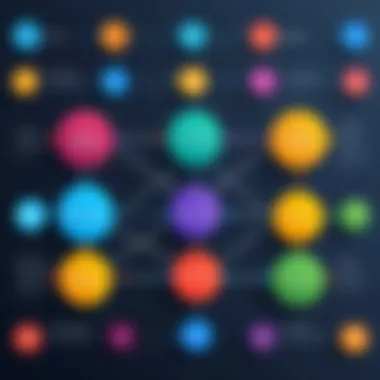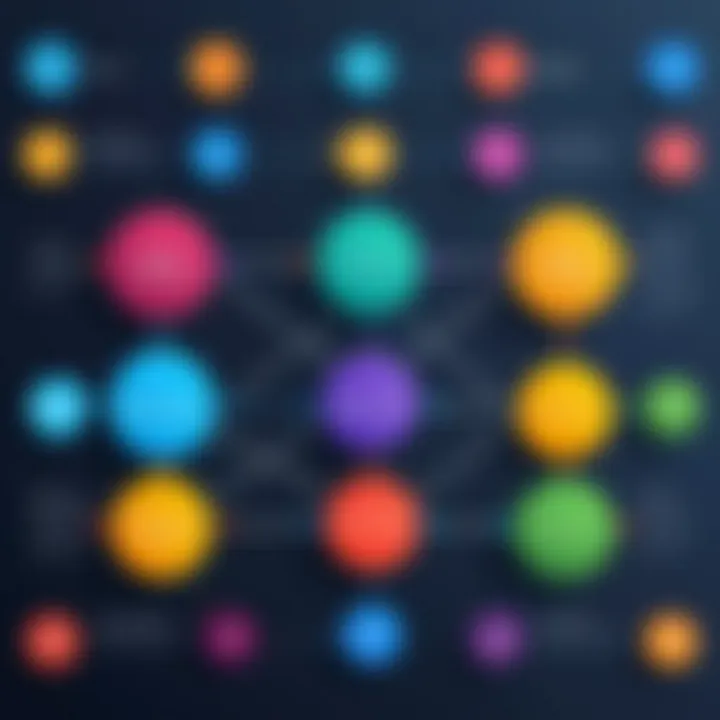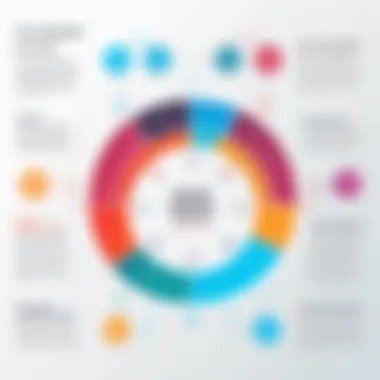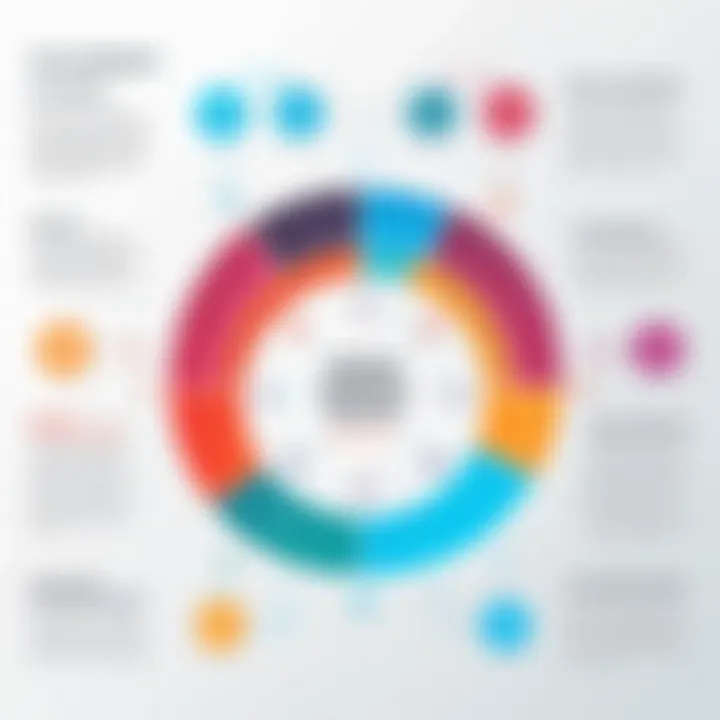Understanding the Mechanisms of Decision-Making


Intro
Decision-making is a vital aspect of human behavior. It occurs daily, in personal lives and professional settings. Understanding the mechanisms behind how decisions are made can provide insights into both efficient choice and potential pitfalls.
This article explores diverse factors influencing decision-making. It emphasizes cognitive biases, social influences, and theoretical frameworks. By examining these elements, we can appreciate their complexity and significance.
Technology Insights
Latest Tech Trends
Today, technology has not only transformed how we communicate but also how we make decisions. Algorithms play a major role in shaping choices. From online shopping to social media interactions, algorithms often determine what options to present. This impacts decision quality and time taken for choices.
Innovation in Tech
Innovative tools are emerging that aid in decision-making processes. For example, machine learning and artificial intelligence provide predictive analytics. These technologies analyze data patterns, which help individuals and organizations to forecast outcomes. Understanding how these innovations work is crucial for making informed decisions.
Product Reviews
Consider the influence of product reviews on consumer decisions. Analysis of star ratings and customer feedback can sway a buyer’s choice. Research confirms that people often rely on this information to minimize risks. Positive reviews enhance trust and encourage purchases, while negative reviews can dissuade potential customers. Therefore, understanding how to evaluate reviews is important for sound decision-making.
"The effective evaluation of product information can significantly influence purchasing decisions."
Cognitive Biases in Decision-Making
Cognitive biases are systematic patterns of deviation from norm or rationality in judgment. They heavily influence how choices are made. Some of the most notable biases include:
- Confirmation Bias: Focusing on information that supports existing beliefs, ignoring contradictory data.
- Anchoring Bias: Relying heavily on the first piece of information encountered when making decisions.
- Overconfidence Bias: Overestimating one’s own abilities or knowledge, leading to risky choices.
Awareness of these biases can help mitigate their effects, leading to better overall decision quality.
Frameworks and Theories
Several decision-making frameworks can guide individuals in their choices. A few prominent ones include:
- Rational Decision-Making Model: This traditional approach involves identifying the problem, gathering information, evaluating alternatives, and making a decision.
- Bounded Rationality: This concept suggests that while individuals aim for rationality, their ability to process information is limited, leading to satisfice rather than optimize.
- Prospect Theory: This theory explains how people decide between alternatives that involve risk, highlighting how potential losses are perceived more seriously than potential gains.
Both rational and intuitive approaches hold valid merits, adapted to various contexts.
The End
These insights are not merely academic; they have real-world implications. As individuals and organizations face increasingly complex decisions, this knowledge becomes ever more crucial.
Understanding Decision-Making
Understanding decision-making is a crucial aspect of both personal and professional life. It influences how individuals make choices that can affect their future. A comprehensive grasp of decision-making processes not only enhances one's ability to choose effectively but also leads to improved outcomes in various contexts, such as business, personal development, and public policy. By delving into the mechanisms that govern decisions, individuals can recognize patterns in their own choices, making informed adjustments when necessary.
Key elements of understanding decision-making include awareness of cognitive biases, emotional responses, and social influences. Recognizing these factors can empower people to manage their decisions better. For instance, understanding how stress can cloud judgment enables individuals to adopt strategies for clearer thinking during critical moments. Furthermore, effective decision-making often relies on the assessment of risks and benefits. This understanding is paramount in an increasingly complex world, where data-driven choices are becoming the norm.
The benefits of mastering decision-making skills are profound. Improved decision-making can lead to increased personal satisfaction, reduced conflict in group settings, and enhanced strategic thinking in organizations. This article aims to articulate how the cognitive, emotional, and social facets of decision-making interplay, emphasizing the importance of cultivating a nuanced understanding of these processes.
Definition of Decision-Making
Decision-making is the cognitive process of selecting a course of action from among multiple alternatives. This process involves identifying the decision context, evaluating the available options, and choosing one that aligns with the individual’s goals or values.
Decision-making can be simple, such as choosing what to eat for lunch, or complex, like selecting a career path. It entails several steps, often starting with recognizing a need or problem, gathering information, weighing alternatives, and finally making a choice.
This definition highlights that decision-making is not a random act but rather a structured process that can be influenced by various factors. It is crucial to understand that this process is not purely logical; it also has emotional and social dimensions that can introduce biases or lead to suboptimal outcomes.
Importance of Decision-Making
The importance of decision-making cannot be overstated. In many scenarios, the quality of decisions can determine the success or failure of a venture. Poor decisions can lead to financial loss, damaged relationships, or even personal regret. Conversely, making sound decisions can foster growth, enhance relationships, and contribute to an individual's sense of well-being.
Moreover, in organizational contexts, effective decision-making is essential for strategic planning and operational success. Leaders and managers often face decisions that have far-reaching implications. They must consider not only the immediate outcomes but also the long-term effects on the organization, employees, and stakeholders.


To illustrate:
- In business: Poor decision-making can lead to strategic missteps, such as failing to adapt to market changes.
- In healthcare: Decisions made by medical professionals directly affect patient outcomes.
- In public policy: Government decisions can impact large populations significantly, underscoring the need for careful consideration and analysis.
By understanding the underlying mechanisms of decision-making, individuals and organizations can improve their ability to assess situations critically, reduce biases, and ultimately enhance their decision-making competence.
Psychological Foundations
Understanding psychological foundations is crucial to dissect the intricacies of decision-making. This domain encompasses essential mental processes that inform our choices. By recognizing cognitive, emotional, and social influences, we better grasp how decisions are formed and the implications they carry.
Cognitive Processes in Decision-Making
Cognitive processes serve as the core of decision-making. They include perception, memory, reasoning, and problem-solving. The functionality of the human brain in evaluating options and triggers plays a pivotal role. For instance, our ability to recognize patterns affects how we anticipate outcomes based on prior experiences. This is often related to heuristics, mental shortcuts that simplify complex decision-making but can also lead to errors.
"Cognitive processes are the invisible gears driving our decisions, even when we are unaware of them."
Some vital cognitive processes are:
- Attention: Directing focus towards relevant information influences the quality of the decision.
- Analysis: Comparing options and predicting consequences requires robust analytical skills.
- Memory: The recall of past experiences informs future choices, shaping expectations and reducing uncertainty.
These processes combined reveal how intellect plays into making calculated decisions, which often reflects a rational perspective alongside intuition.
Emotional Influences
Emotions also significantly shape decisions. They can both cloud judgment and provide clarity, depending on context. For instance, fear might drive one to avoid risks, while excitement may encourage bold choices. The interplay between emotion and cognition is vital. Emotions can act as signals that prompt decision-makers to act or reconsider, often leading to swift reactions that bypass thorough thought.
Key points about emotional influences include:
- Influence of Stress: High stress can lead to hasty conclusions, often disregarding logical analysis.
- Mood Effects: One's current emotional state can skew perceptions and preferences, impacting the decision-making process.
Recognizing the emotional undercurrents behind decisions can aid in understanding unpredictable behaviors that seem irrational.
Social Influences on Decisions
Social contexts shape our decisions in profound ways. Social pressure, cultural norms, and collective behavior factor into how we decide. This also includes the influence of our peers. Individual decisions may differ significantly when considered in isolation versus in a group. For example, individuals often lean towards conformity, aligning their choices with the majority to fit social expectations.
Significant social influences are:
- Cultural Background: Values and traditions inform decision-making frameworks.
- Peer Pressure: Decisions made in group environments can be steered by the desire for acceptance or fear of isolation.
- Environment: Surroundings often guide choices, swaying preferences based on local customs or available options.
By understanding these social dynamics, we can recognize how external factors mold inner decision models, impacting personal and professional choices.
Theories of Decision-Making
The exploration of decision-making theories offers a framework for understanding how choices are made both individually and collectively. These theories elucidate the thought processes behind decisions, highlighting why certain paths are chosen over others. With the integration of various psychological and economic concepts, understanding these theories allows for better strategies in both personal and organizational settings.
Rational Choice Theory
Rational Choice Theory posits that individuals make decisions based on the maximization of utility. This means people weigh the benefits and costs of each option, aiming to choose the one that provides the highest personal gain.
- Key Components: The theory relies on several assumptions, including that decision-makers have preferences among choices that are consistent and transitive. This means that if an individual prefers option A over B, and B over C, then they should prefer A over C.
- Applications: Rational Choice Theory can be particularly useful in economics, helping to predict market behaviors based on individuals' decision-making processes. It also serves as a foundation for understanding consumer behavior.
- Limitations: Critiques of this theory argue that it oversimplifies human behavior. In reality, decisions are often affected by biases and emotions, which may lead people to make choices that do not align with purely rational calculations.
Bounded Rationality
Bounded Rationality introduces a more realistic approach to understanding decision-making. Proposed by Herbert Simon, this theory acknowledges that while individuals strive to make rational choices, their ability to do so is limited by various factors, such as cognitive limitations and time constraints.
- Key Elements: Instead of optimizing decisions, individuals often satisfice, meaning they look for a solution that meets a minimum criterion rather than the best possible outcome. This approach reflects how humans navigate complex information and limited resources.
- Practical Implications: In real-world scenarios, businesses may utilize bounded rationality to streamline decision processes. For instance, leaders can simplify choices to help teams reach satisfactory solutions rather than exhaustive analyses of every option.
- Critique: Critics point out that bounded rationality may lead to suboptimal decisions. However, it remains a beneficial lens for viewing decision-making in everyday situations where time and resources are limited.
Prospect Theory
Prospect Theory, developed by Daniel Kahneman and Amos Tversky, fundamentally challenges the assumptions of Rational Choice Theory. It explores how people actually make decisions under risk and uncertainty, often deviating from rational models.
- Value Function: One of the central concepts is the value function, which suggests that people evaluate potential losses and gains differently. Losses loom larger than gains, meaning the pain of losing is more intense than the pleasure from a comparable gain.
- Decision Weights: The theory also posits that individuals tend to overweigh small probabilities and underweigh moderate to high probabilities, skewing their risk assessments.
- Application in Various Fields: Understanding Prospect Theory can help in behavioral economics, marketing, and public policy by anticipating how people will react to different risk scenarios. By framing choices effectively, decision-makers can steer individuals towards better outcomes.
"Understanding these decision-making theories is essential for improving both personal choices and organizational strategies."


The combination of these theories offers a comprehensive perspective on decision-making. They cover the breadth of human choice behavior, accounting for rational processes as well as the cognitive limitations that shape our decisions. In a world that is increasingly complex, these insights become invaluable for anyone seeking to navigate choices more effectively.
Cognitive Biases and Heuristics
Common Cognitive Biases
Many cognitive biases exist, each affecting decision-making in unique ways. Here are some notable examples:
- Confirmation Bias: This is the tendency to search for, interpret, and remember information that confirms existing beliefs. It skews the evaluation of evidence and often leads to poor choices.
- Anchoring Effect: When an initial piece of information serves as a reference point, subsequent judgments are influenced by that anchor. This can severely distort perception.
- Overconfidence Bias: This bias occurs when individuals overestimate their knowledge or abilities. It can result in poor decision outcomes due to a lack of realistic self-assessment.
- Availability Heuristic: People often rely on immediate examples that come to mind. This can lead to flawed assessments, especially if the remembered events are not representative.
Awareness of these biases is necessary for improved decision-making.
Impact of Heuristics
Heuristics allow for faster decisions in uncertain situations, however, their usage can also lead to significant pitfalls. Here are some impacts:
- Efficiency: Heuristics enable quick responses that can be useful in time-sensitive situations.
- Simplicity: They simplify complex decision-making processes, making it easier to navigate choices.
- Risk of Error: While they speed up decisions, heuristics can also facilitate error-prone judgments. For instance, familiarity may misguide people into trusting unreliable sources.
Overall, heuristics play a dual role, benefitting speed but potentially harming precision in choices.
Mitigating Biases
Addressing cognitive biases starts with awareness and can lead to more balanced decision-making. Here are strategies to mitigate them:
- Education: Familiarize oneself with different cognitive biases and heuristics. Understanding their existence can reduce their influence.
- Critical Thinking: Encourage logical reasoning. Systematic evaluation minimizes emotional responses that may distort judgment.
- Consult Diverse Perspectives: By engaging with varying opinions, one can challenge their biases and improve decision quality.
- Use Decision-Making Frameworks: Employ structured methodologies that guide thought processes, ensuring thorough analysis before a conclusion.
In summary, recognizing and managing cognitive biases can enhance decision-making effectiveness, leading to better outcomes across various contexts.
Understanding cognitive biases and heuristics is vital in making informed, effective decisions.
Decision-Making Processes
Understanding decision-making processes is critical because they underpin our actions across various contexts, from personal choices to significant policy decisions. Every decision involves a sequence of steps, with each phase having its own set of considerations. Recognizing these steps can facilitate better outcomes as eager decision-makers can navigate the uncertainties associated with their choices. The advantages of this understanding extend beyond individual actions, as they help in group decisions or organizational strategies where multiple viewpoints may clash.
The Steps in Decision-Making
The decision-making process generally comprises several key steps. These steps follow a logical progression that, when adhered to, can lead to outcomes aligned with the targeted objectives:
- Identifying the Problem: This first step requires one to clearly understand the issue at hand. Without a precise diagnosis, it's challenging to move forward effectively.
- Gathering Information: A thorough examination of available data, options, and resources is essential. This can often involve charts, reports, or even advice from seasoned experts to reveal possible alternatives.
- Identifying Alternatives: Listing potential options requires creativity and analytical skills. An array of alternatives allows for more informed decisions, fostering better outcomes.
- Weighing Evidence: Each alternative must be examined. Consider the positive and negative impacts each option might bring. This evaluative step helps clarify priorities.
- Choosing Among Alternatives: After weighing options, the next natural step is making a selection based on the gathered evidence and individual or collective objectives.
- Taking Action: Once a choice is made, it's critical to implement it properly. Deliberate actions support the decision and tie back to the initial problem.
- Reviewing the Decision: Finally, examining the consequences of the decision is important. This reflective stage allows for adjustments and learning for future scenarios.
Group vs Individual Decision-Making
Decisions made by individuals often differ significantly from those made in a group setting. Individual decision-making can be influenced by personal experiences, biases, and cognitive limitations. The speed of decision-making can be one advantage, allowing for quicker resolutions. However, that speed often sacrifices breadth and feedback potential.
In contrast, group decision-making allows for diverse perspectives, which can enhance the quality of the outcome. The collective knowledge pooled within a group can foster creativity and expansive horizons. Nonetheless, it can bring challenges such as groupthink, where members suppress dissenting opinions for harmony. Understanding when to favor individual decisions over group consensus is essential for effective problem-solving.
Role of Technology in Decision-Making
Today, technology plays a vital role in shaping decision-making processes. Various tools and platforms are available that enable individuals and groups to analyze data more efficiently, forecast outcomes using simulations, and visualize complex information. For instance, data analytics software can uncover patterns in data that human analysis might miss. Additionally, online collaboration tools enhance group interactions, allowing for real-time brainstorming and feedback.
However, reliance on technology also carries risks. Over-dependence on analytics can obscure intuitive judgments that are based on experience. Inappropriate use of technology may lead to biased conclusions or reinforce existing prejudices. Hence, it's critical for decision-makers to balance technological assistance with their judgment, ensuring that technology enhances but does not dominate the decision-making landscape.
Effective decision-making requires a fusion of analytical skills, emotional intelligence, and technological savvy.
By recognizing the intricacies of these processes, individuals can enhance their decision-making competence significantly, improving outcomes across various areas of life.
Case Studies in Decision-Making
Case studies in decision-making are crucial for understanding the practical application of theoretical concepts. They provide real-world examples that illustrate how individuals and organizations navigate complex scenarios. Learning from such instances helps to unveil the underlying mechanics of choices made under varying circumstances. Examining these from different fields adds layers of insight that can enhance decision-making skills.
Business Contexts
In business, decision-making can often have far-reaching effects. For example, consider the case of Blockbuster, which failed to adapt to changing market conditions due to poor decisions regarding digital streaming services. Netflix, on the other hand, made strategic decisions that leveraged emerging technology and shifting consumer preferences.
Key points from the Blockbuster vs. Netflix case:


- Lack of foresight: Blockbuster underestimated the potential of online streaming.
- Disregard for consumer trends: They did not align their services to meet changing demands.
- Innovation comparison: Netflix embraced new technology and pivoted effectively.
These elements are vital for anyone studying decision-making. They show that awareness of the environment and timely responses are fundamental for success and survival in competitive fields.
Medical Decisions
In the medical field, decision-making is often complex and can influence patient outcomes significantly. A case that exemplifies sound medical decision-making is that of the MMR vaccine. Despite the controversy fueled by misleading reports, studies and collective data demonstrated the vaccine's safety and importance in preventing diseases.
Factors considered in this case include:
- Evidence-based practice: Rich data supported vaccine efficiency.
- Ethical responsibility: Physicians weighed the benefits against misinformation.
- Patient autonomy: Decisions were rooted in the necessity to inform patients correctly.
Such case studies clarify how decisions in healthcare are guided by rigorous evidence and ethical considerations, affecting both individual treatment plans and public health policies.
Public Policy Decisions
Public policy decisions often encompass large-scale implications. A pertinent case is the implementation of the Affordable Care Act (ACA) in the United States. The ACA aimed to increase healthcare coverage but faced numerous challenges and opposition.
Key considerations in public policy decision-making:
- Stakeholder involvement: Diverse opinions from both citizens and politicians influenced the policy’s design.
- Impact assessment: The anticipated effects on healthcare availability and costs were thoroughly analyzed.
- Implementation challenges: Resistance from various sectors shaped the execution process.
These case studies demonstrate that successful public policy decisions require comprehensive analysis and inclusive frameworks. The implications of such decisions can resonate through society for years.
"Decisions in complex contexts can yield lessons that transcend specific scenarios, benefiting a broader audience."
The insights gained from these case studies serve as valuable references for tech-savvy individuals aiming to enhance their own decision-making processes, ensuring they are equipped with both knowledge and practical frameworks.
Implications of Poor Decision-Making
The implications of poor decision-making are vast and can affect various sectors and individuals significantly. Understanding these implications is crucial in recognizing the impact that decisions can have both in the short and long term. Poor decisions can lead to negative consequences, waste resources, and erode trust among stakeholders. This article examines the importance of these implications in shedding light on the need for better decision-making practices.
Consequences in Various Fields
In different fields, the consequences of poor decision-making can manifest in alarming ways.
- Business: Companies may suffer financial losses or reputational damage. For instance, unfavorable strategies can lead to market share decline. A poor decision to enter a new market without adequate research has resulted in many corporate failures.
- Healthcare: In medical contexts, incorrect decisions can directly affect patient outcomes. Misdiagnoses or improper treatments can lead to chain reactions in a patient’s health trajectory, sometimes resulting in severe consequences like complications or death.
- Public Policy: Decisions made in governance can result in ineffective laws or programs. Poor policy decisions often have wide-reaching implications affecting societal well-being, resource allocation, and public trust in institutions.
Ethical Considerations
Ethical considerations in decision-making are vital. Poor decisions can reflect a lack of integrity or disregard for values.
- Transparency: Decision-makers must approach choices with an honest manner. If stakeholders feel misled, the decision's legitimacy comes into question.
- Accountability: Providers of decisions must be held accountable for their outcomes. A lack of accountability can breed future irresponsible behavior, knowing there are few consequences for poor choices.
Decisions influenced by unethical practices can deepen societal problems, fostering environments where mistrust thrives. It is essential for individuals and organizations alike to recognize that their decisions shape not only their immediate environment but also the larger community.
"Awareness of the implications of decision-making is a step toward fostering responsible and informed choices."
Enhancing awareness of these implications encourages improving the overall quality of decisions made across various sectors. Recognizing potential pitfalls is essential in mitigating risks and fostering more effective decision-making processes.
Enhancing Decision-Making Competence
Enhancing decision-making competence is a critical aspect of navigating the complexities of our modern world. As individuals and organizations face increasingly intricate problems, having the ability to make informed and effective decisions becomes essential. This section delves into key strategies and systematic approaches that can improve decision-making skills and ultimately lead to better outcomes. The emphasis is on practical elements and the benefits of refining one's decision-making process.
Strategies for Better Decisions
To effectively enhance decision-making competence, individuals should consider adopting various strategies. These strategies enable one to systematically approach decisions and mitigate the potential for errors. Here are some crucial strategies:
- Define Clear Goals: Establishing clear objectives is foundational. Knowing what you aim to achieve helps in evaluating options and making better choices.
- Gather Relevant Information: Being informed is key. Collect data that pertains specifically to the decision at hand. This means not only relying on primary sources but also analyzing trends and patterns that could affect outcomes.
- Debate Alternatives: Sometimes, discussing options with trusted colleagues or peers can reveal insights that one may overlook. Encourage open dialogue to assess different perspectives.
- Utilize Decision-Making Frameworks: Applying structured approaches like SWOT analysis or the Decision Matrix can help organize thoughts and filter out less viable options effectively.
- Follow-Up Review: Post-decision evaluation should not be neglected. Reviewing outcomes can offer lessons that refine future decision-making processes.
Implementing these strategies fosters a disciplined approach to decision-making. They also encourage a mindset that values reflective thinking and continuous improvement.
Training and Development
Training plays a pivotal role in enhancing decision-making competence. Organizations can invest in targeted programs that provide employees with the tools necessary for effective decision-making. This includes workshops, online courses, and mentorship initiatives. Key focus areas for such programs may include:
- Critical Thinking Skills: Developing the ability to analyze scenarios helps in recognizing biases and evaluating the impacts of potential decisions.
- Scenario Planning: Training that involves hypothetical situations can prepare individuals to think through various outcomes and make calculated decisions based on evidence.
- Emotional Intelligence: Building awareness of one's own emotional responses and those of others can significantly affect decision-making in group settings.
- Cultural Sensitivity: In diverse workplaces, understanding different cultural perspectives is vital. Training can enhance awareness of how culture affects decision-making.
By prioritizing these training areas, organizations not only foster individual competence but also create a culture of informed decision-making.
"The ability to make thoughtful decisions is not just a skill; it's a prerequisite for success in any environment."







